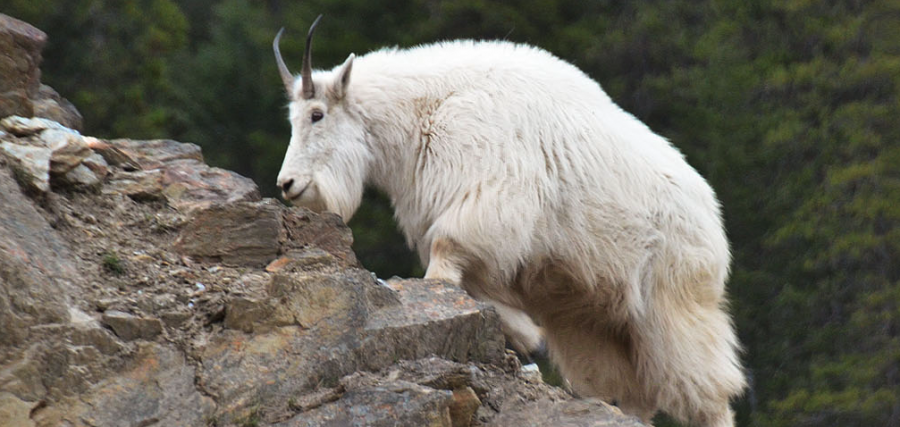Mountain goats have had a continuous presence in North America since they plodded across the Bering Strait tens of thousands of years ago, and the fluffy white creatures are ubiquitous on signs and statues throughout the Robson Valley. Despite their endearing place in local iconography, the valley’s mountain goat population has been declining over the past few decades – and researchers are unsure why.
However, new research under way in the Robson Valley may give clues as to why populations are declining. Led by Kara MacAulay, a Prince George-based wildlife biologist for the Ministry of Water, Land and Resource Stewardship, the study will track 30 female mountain goats using GPS collars.
This is the fourth study on Robson Valley mountain goat populations, which have recorded an alarming decline in the number of goats since the first study in 1998, said MacAulay.
“There’s about a 70 per cent decline in numbers from the 1998 survey to the most recent one [in 2021],” MacAulay said. “Other biologists are also noticing similar declines… it’s really an unknown cause of decline. The same goes for the population in the Robson Valley – we don’t really know what the decline is caused by.”
One early theory was that overhunting could be impacting the population, but the evidence has not shown that hunting is the cause, according to MacAulay. The mountain goat harvest has been kept under the recommended three per cent of the population per year, with very few females harvested, she said. Additionally, areas which do not allow hunting – such as Mount Robson Provincial Park and Alberta’s Castle Provincial Park – have seen similar declines in their mountain goat populations, MacAulay said.

Other working theories for the decline include habitat changes or a lack of food making it harder for goats to survive and raise offspring, but it’s difficult to speculate on the cause, according to MacAulay.
So far, researchers have deployed 20 collars on local mountain goats, and they will add the remaining 10 collars next winter. The collars allow researchers to track the survival of goats by sending an alert when a goat has not moved for several hours. Researchers will then travel to the site where the goat was last recorded and determine its cause of death, whether it was health-related, predation-related, or a natural death caused by an event such as an avalanche.
Researchers will also do one to two recruitment surveys a year, meaning they will use a helicopter to find collared goats and see if they have offspring with them. MacAulay said this will help researchers determine if high juvenile mortality rates are behind the population decline.
Conservation is the main goal of the study, MacAulay said. Aside from the socioeconomic reasons for preserving mountain goat populations – people travel from across the world to hunt goats in B.C. every year, according to MacAulay – they have cultural significance to First Nations and B.C. residents in general, she added. Once researchers identify the cause – or causes – of decline, they can work with local governments and the Ministry of Water, Land and Resource Stewardship to implement policy changes that may help sustain mountain goat populations throughout the province.
“We don’t want to see declines in these populations, especially when we don’t know the cause,” MacAulay said. “If we can figure out the cause, maybe we can either stop or reverse that decline.”
The research is funded through a grant from the Habitat Conservation Trust Foundation, a Victoria-based nonprofit which funds habitat restoration and studies on fish and wildlife.
The Foundation recently granted a total of $8.6M to 110 projects throughout B.C., said CEO Dan Buffett.
“The goal is to improve outcomes for fish, wildlife and [their] habitats,” Buffett said. “We know they’ve experienced lots of decline in many of those populations over the years. It’s trying to return those populations and also to protect, restore and enhance habitat for those fish and wildlife species.”
The mountain goat study is just the latest in a slew of projects the organization has funded in northern B.C., Buffett added. According to him, the Foundation also funded a project to remove unused roads in Sugarbowl-Grizzly Den Provincial Park in 2023 because they disrupted animal movement, and in the same year the organization worked with First Nations to improve caribou habitat near Kinbasket Lake.
The Foundation is funded through provincially-mandated fees for hunting and fishing licences, and supporters can donate online at hctf.ca. Occasionally, the Foundation funds projects that locals can get involved in, such as the annual B.C. bat counting project, where residents count bats at roost sites near where they live.
However, Buffett says one of the best things nature-lovers can do is spend time outdoors.
“Get out into nature – it’s good for our physical and mental health, and helps us appreciate the value that wetlands and forests and grasslands have for us,” he said. “You recognize that nature needs space, so it’s important to protect it.”


















